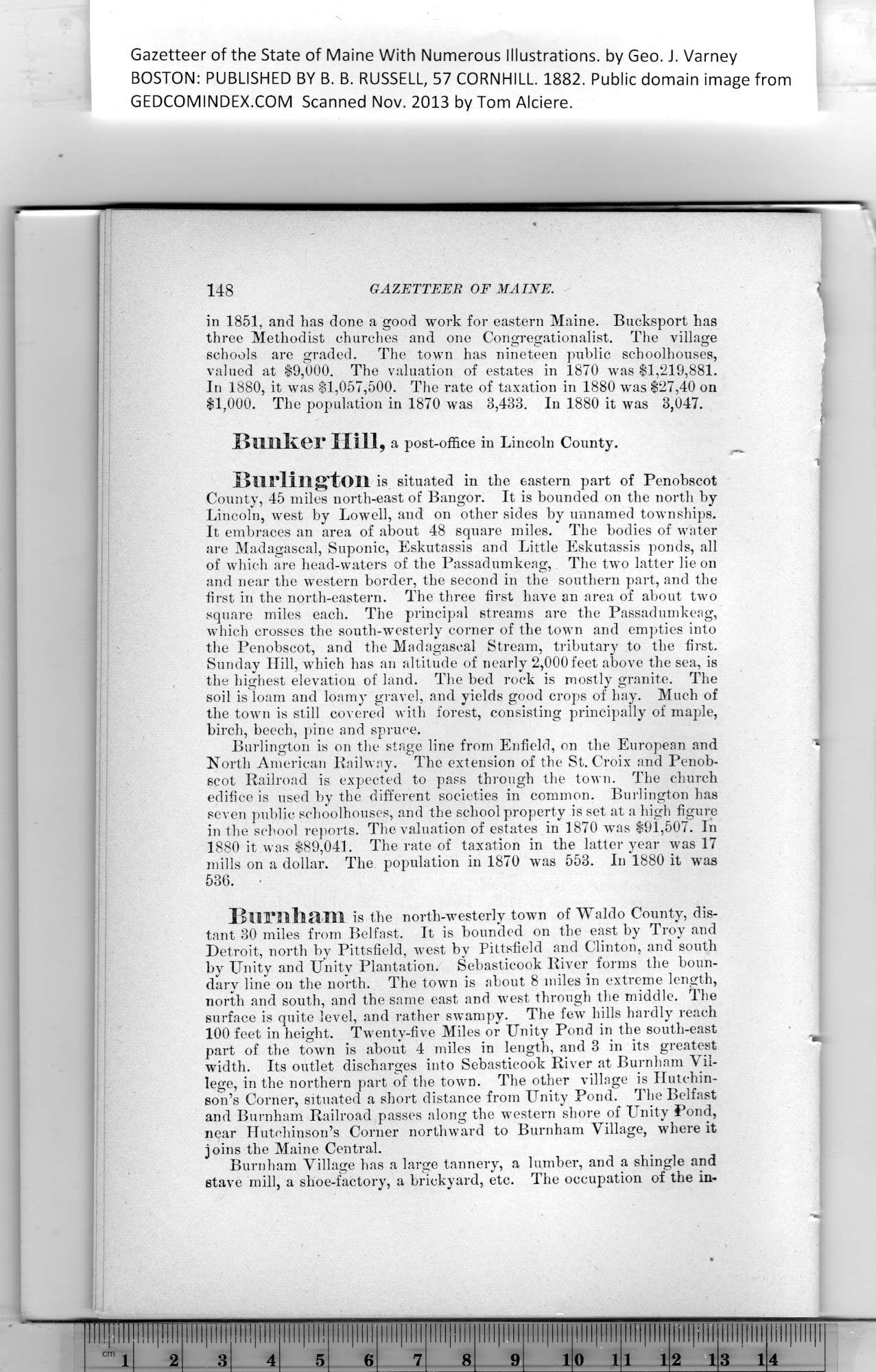|
Gazetteer of the State of Maine With Numerous Illustrations, by Geo. J. Varney
BOSTON: PUBLISHED BY B. B. RUSSELL, 57 CORNHILL. 1882. Public domain image from
148 GAZETTEER OF MAINE.
in 1851, and has done a good work for eastern Maine. Bucksport has
three Methodist churches and one Congregationalist. The village
schools are graded. The town has nineteen public schoolhouses,
valued at $9,000. The valuation of estates in 1870 was $1,219,881.
In 1880, it was $1,057,500. The rate of taxation in 1880 was $27,40 on
$1,000. The population in 1870 was 8,433. In 1880 it was 3,047.
Bunker Hill, a post-office in Lincoln Coiinty.
Burlington is situated in the eastern part of Penobscot
County, 45 miles north-east of Bangor. It is bounded on the north by
Lincoln, west by Lowell, and on other sides by unnamed townships.
It embraces an area of about 48 square miles. The bodies of water
are Madagascal, Suponic, Eskutassis and Little Eskutassis ponds, all
of which are head-waters of tbe Passadumkeag, The two latter lie on
and near the western border, the second in the southern part, and the
first in the north-eastern. The three first have an area of about two
square miles each. The principal streams are the Passadumkeag,
w'hich crosses the south-westerly corner of the town and empties into
the Penobscot, and the Madagascal Stream, tributary to tbe first.
Sunday Hill, which has an altitude of nearly 2,000 feet above the sea, is
the highest elevation of land. The bed rock is mostly granite. The
soil is loam and loamy gravel, and yields good crops of hay. Much of
the town is still covered with forest, consisting principally of maple,
birch, beech, pine and spruce.
Burlington is on the stage line from Enfield, on the European and
North American Railway. The extension of the St. Croix and Penob-
scot Railroad is expected to pass through the town. The church
edifice is used by the different societies in common. Burlington has
seven public schoolhouses, and the school property is set at a high figure
in the school reports. The valuation of estates in 1870 w’as $91,507. In
1880 it was $89,041. The rate of taxation in the latter year was 17
mills on a dollar. The population in 1870 was 553. In 1880 it was
536.
Burnham is the north-westerly town of Waldo County, dis-
tant 30 miles from Belfast. It is bounded on the east by Troy and
Detroit, north by Pittsfield, west by Pittsfield and Clinton, and south
by Unity and Unitv Plantation. Sebasticook River forms the boun-
dary line on the north. The town is ahout 8 miles in extreme length,
north and south, and the same east and west through the middle. The
surface is quite level, and rather swampy. The few hills hardly reach
100 feet in height. Twenty-five Miles or Unity Pond in the south-east
part of the town is ahout 4 miles in length, and 3 in its greatest
width. Its outlet discharges into Sebasticook River at Burnham Vil-
lege, in the northern part of the town. The other village is Hutchin-
son’s Corner, situated a short distance from Unity Pond. The Belfast
and Burnham Railroad passes along the western shore of Unity Pond,
near Hutchinson’s Corner northward to Burnham Village, where it
joins the Maine Central.
Burnham Village has a large tannery, a lumber, and a shingle and
stave mill, a shoe-factory, a brickyard, etc. The occupation of the in-
PREVIOUS PAGE ... NEXT PAGE
This page was written in HTML using a program written in Python 3.2
|
